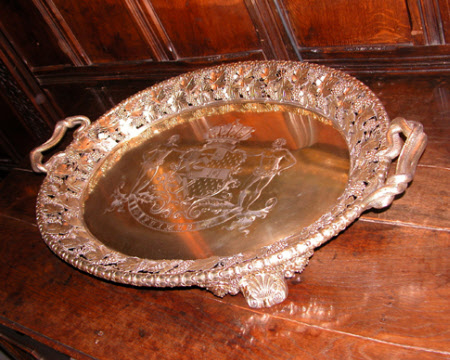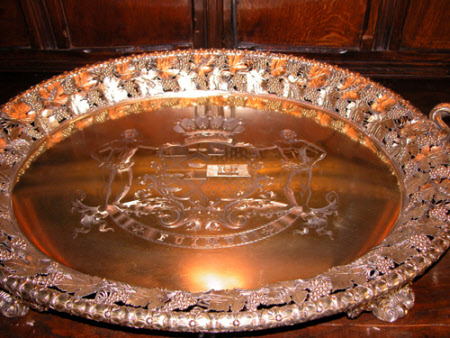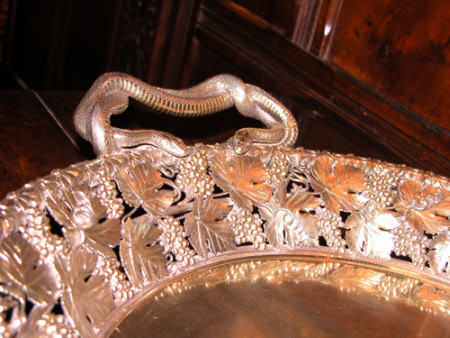Tray
Paul Storr (1771-1844)
Category
Silver
Date
1818 - 1819
Materials
Silver-gilt, sterling
Measurements
10.7 x 75.3 x 51.1 cm
Place of origin
London
Order this imageCollection
Anglesey Abbey, Cambridgeshire
NT 516404
Summary
A large two-handled oval tray, silver-gilt (sterling), mark of Paul Storr for Rundell, Bridge & Rundell, London, 1818/9. The oval surface of the tray is made from a sheet of silver hammered flat. The wide openwork border of vine leaves, grapes and tendrils is cast in small sections and soldered to a central twisted wire. Applied to its rim is a narrow cast border of quatrefoils between bunches of tied leaves. L-shaped flanges are soldered to the inside edge of the vine leaf border and the rim of the flat surface of the tray. These flanges overlap and hold the two parts of the tray together with 20 nuts and bolts. Each handle is cast in the form of a pair of entwined snakes whose heads rest on the rim of the outer border. The underside of the rim is soldered to four large bracket feet, each cast in the form of a scallop shell between acanthus and vine leaves and bunches of grapes. There are casting blow holes under the rim and in the handles. The centre of the tray is engraved with armorials.Heraldry: The coat of arms, supporters and motto beneath an earl’s coronet are for BRUCE quartering BRUDENELL for Charles Brudenell-Bruce (1773-1856), 2nd Earl of Ailesbury (later 1st Marquess of Ailesbury) impaling HILL, for his first wife, the Hon. Henrietta Maria Hill (c.1773-1831). Scratch weight: None
Full description
NOTES ON THE TRAY Paul Storr’s phenomenal ability to manage a large manufacturing workshop as well as his skill at working with London’s finest designers, modellers, and craftsmen meant that he became an indispensable supplier of plate to several of London’s largest and smartest retailers. In 1807 he was persuaded to accept a partnership with Philip Rundell, John Bridge and Edmund Waller Rundell, forming Storr & Co, with a factory in Dean Street, where he was contracted to make a certain weight of silver each month. Storr oversaw the work of the design studio, workshop and contractors, which included the firm of engravers run by Walter Jackson (1780?-1834) of Gutter Lane. Jackson gained his freedom in 1801; the same year that, on the death of his master John Thompson, he took over his business and acquired two apprentices. In 1815 Samuel Jackson (probably a nephew) joined as an apprentice. He became free in 1822 and continued the business into the third quarter of the 19th century. [1] The Victoria & Albert Museum holds an album of their pulls and crests, making it possible to identify some of their work, much of which was for the Royal family. Walter Jackson’s workshop was probably responsible for the arms engraved on two matching large trays sold by Rundell’s to the 2nd Earl of Ailesbury. Anglesey Abbey’s tray was hallmarked in 1818/9, and is of the same design and similar size as one hallmarked four years earlier in 1814/5, which presumably was ordered by the Earl shortly after the death of his father, the 1st Earl, in April 1814. It was sold by Lord Piers Brudenell-Bruce at Sotheby’s in 1969; subsequently in the Lillian and Morrie Moss Collection, before being sold by Garrards in 1981, and later by Koopman Rare Art. It has yet to be established when Anglesey Abbey’s tray was acquired. Vine leaf and grape borders, made by the casting of individual parts before soldering them to tendril-like wires, and then to a central twisted wire at the back of the border, were used extensively in the first two decades of the 19th century on silver made for Rundell’s in the workshops run by Benjamin Smith and Paul Storr. These borders appear on dessert stands such as the pair owned by Lord Fairhaven (516513) as well as on salvers, coasters and baskets. Examples of other trays with similar borders, but often with different handles or feet, include a set of three, ranging in size and with armorials engraved by Jackson, which were made for the 1st Marquess of Ormonde; as well as single examples in the Gilbert Collection [4], the Metropolitan Museum of Fine Art [5], and The National Gallery of Victoria [6]. [1] Charles Oman: English Engraved Silver 1150-1900, London, 1978, pp 123-126 [2] Sotheby’s sale of Fine English and Foreign Silver and Plate, London, 17 July 1969, lot 261, sold for £3,400 [3] Morrie A Moss: The Lillian and Morrie Moss Collection of Paul Storr Silver, 1972, pp 240-241, plate 178 [4] The Victoria & Albert Museum, London: accession number: LOAN:GILBERT.834-2008 [ 5] The Metropolitan Museum of Fine Art, New York: accession Number: 1977.436.3 [6] The National Gallery of Victoria, Australia: accession number: D65-1978 HERALDRY The arms are those of Charles Brudenell-Bruce (1773-1856) as 2nd Earl of Ailesbury, later 1st Marquess of Ailesbury, and his first wife, the Hon. Henrietta-Maria Hill (c.1773-1831), daughter of Noel Hill, 1st Baron Berwick of Attingham whom he married in 1793. After a private education upon leaving Leyden University he embarked on a Grand Tour. In 1791 when Lady Malmesbury met him in Italy she described the then Lord Bruce as ‘quite Lord Ailesbury just out of the shell - which, by the by, is no bad comparison, for they are like unfledged turkeys’. She crossed his path again soon afterward and deemed him ‘a sad goose, but a good humoured creature and so desperately in love with the Duchesse de Fleury it is quite melancholy. Lord Malmesbury says he is in love like a rabbit with a bunch of parsley’. However his romantic prospects changed dramatically when he rescued the Hon. Henrietta Maria Hill from a serious riding accident when her horse bucked. They were married in Italy in 1793. Horace Walpole’s assessment of him as, ‘a formal, dull, man, totally ignorant of and unversed in the world, and a Tory; very unexceptionable in character.’ is a less sympathetic assessment than that of Lady Malmesbury. Upon the young couple’s return to England his father had him returned to Parliament in the House of Commons for the family controlled seat the borough of Marlborough as soon as he was of age. He remained a Member of Parliament until his father’s death in 1814 when he inherited the earldom and thereby a seat in the House of Lords. He does not appear to have been particularly active or reliable in his parliamentary career. Both he and his father thought the family might be rewarded with a marquessate for support of the Portland administration of 1807-1809, for which he applied, but one was not forthcoming. The 2nd Earl was finally rewarded with the title Marquess of Ailesbury in the Coronation honours of George IV in 1821 - which may not be unconnected with the Trial of Queen Caroline where he is quite prominently included in the painting of this subject by Sir George Hayter (NPG999). The engraving shows an earl’s rather than a marquess’s coronet so can be placed within a narrow date band of 1818-1821, the date of the tray and the period before he was created a marquess. The Marquess’s first wife died in 1831 and subsequently he remarried. However, fortunately the magnificent engraving remained unaltered. The 4th Marquess, George William Thomas Brudenell-Bruce (1863-1894) was a compulsive gambler both before and after he inherited the title. The estate was almost bankrupted and all the property in Yorkshire was sold for nearly £175,000 to meet one round of debts. The Savernake estates in Wiltshire along with post of Hereditary Warden of Savernake Forest were saved after sustained legal action which, along with the long life of 1st Marquess’s second wife who died in 1893, may have protected the movable family assets at Tottenham House, Wiltshire. Jane Ewart, 2025 Heraldry by Gale Glynn
Provenance
Charles Brudenell-Bruce, 2nd Earl of Ailesbury (1773–1856) (Urban) Huttleston Rogers Broughton, 1st Baron Fairhaven (1896-1966) bequeathed to the National Trust along with the house and the rest of the contents National Trust .
Credit line
Anglesey Abbey, the Fairhaven Collection (National Trust)
Marks and inscriptions
On the underside of the tray: Hallmarks: ‘PS’ (Paul Storr*), lion passant (sterling), leopard’s head (London), ‘c’ (1818/9), and monarch’s head (duty mark) *Arthur Grimwade: London Goldsmiths 1697-1837, 1990, p 162, no 2235 On the border’s L-shaped flange: Partial hallmarks: ‘PS’, lion passant and monarch’s head On the underside of the tray: Retailer’s/manufacturer’s stamped mark: ‘RUNDELL BRIDGE ET RUNDELL AURIFICES REGIS ET PRINCIPIS WILLIAE REGENTIS BRITANNIAS’ and ‘RUNDELL’ On the border’s L-shaped flange: Stamped design number: ‘452’ On the border’s L-shaped flange: Old NT inventory mark in white ink: ‘AA/S/13’
Makers and roles
Paul Storr (1771-1844), goldsmith Rundell, Bridge and Rundell, retailer




